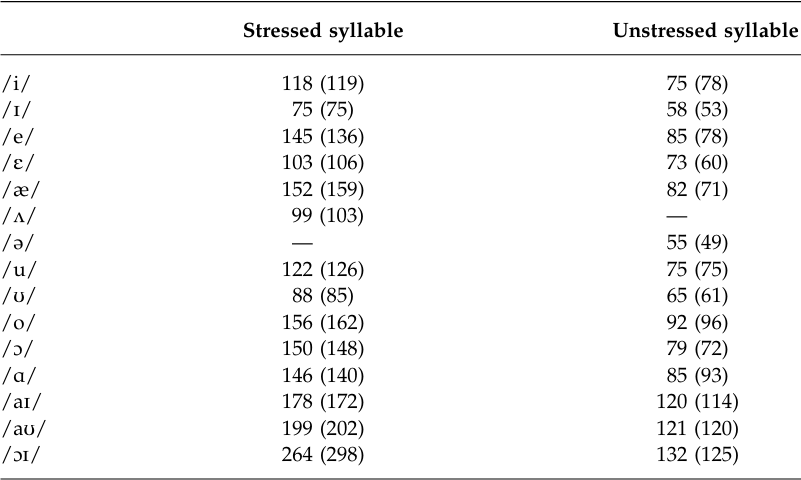


 Grammar
Grammar
 Tenses
Tenses
 Present
Present
 Past
Past
 Future
Future
 Parts Of Speech
Parts Of Speech
 Nouns
Nouns
 Verbs
Verbs
 Adverbs
Adverbs
 Adjectives
Adjectives
 Pronouns
Pronouns
 Pre Position
Pre Position
 Preposition by function
Preposition by function 
 Preposition by construction
Preposition by construction
 Conjunctions
Conjunctions
 Interjections
Interjections
 Grammar Rules
Grammar Rules
 Linguistics
Linguistics
 Semantics
Semantics
 Pragmatics
Pragmatics
 Reading Comprehension
Reading Comprehension|
Read More
Date: 2024-04-09
Date: 26-3-2022
Date: 14-4-2022
|
Diphthongs
Diphthongs are different from monophthongal vowels in that the vocal tract changes size and shape, due to the tongue moving in order to produce one vowel quality followed by another, and thus the formants are not horizontal throughout as they are in monophthongal vowels. The changes in the vocal tract shape for diphthongs can be observed from the movements of the first three formants.
Table 1 Duration of English vowels in stressed and unstressed syllables (in milliseconds).

Note: The values given come from the averages of the productions of a list-reading task from three adult native speakers (from Iowa, Ohio, and Florida). The values in parentheses next to those of our three subjects are from Crystal and House (1982). One can easily see the remarkable similarities between the two studies.
The diphthong /aɪ/ starts with a low back constriction and ends with a high front constriction. Accordingly, F2 rises as the constriction moves from back to front, and F1 falls as the constriction moves from low to high. In /aʊ/, a low back constriction moves to a high back constriction. As the tongue rises, F1 falls; F2 also falls because some movement of the tongue occurs farther back for /ʊ/ than /a/; also, due to lip rounding of /ʊ/, all resonance frequencies are lowered. Finally, /ɔɪ/ starts as a low back vowel and ends as a high front vowel. As the tongue moves from back to front, F2 rises; as the tongue moves from low to high, F1 falls. We can observe all the points made above in the spectrogram of the sentence Brian Boitano bowed[braɪn bɔɪtano baʊd] (Consonants Figure 1).
|
|
|
|
دخلت غرفة فنسيت ماذا تريد من داخلها.. خبير يفسر الحالة
|
|
|
|
|
|
|
ثورة طبية.. ابتكار أصغر جهاز لتنظيم ضربات القلب في العالم
|
|
|
|
|
|
|
سماحة السيد الصافي يؤكد ضرورة تعريف المجتمعات بأهمية مبادئ أهل البيت (عليهم السلام) في إيجاد حلول للمشاكل الاجتماعية
|
|
|